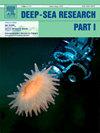台湾峡谷-马尼拉海沟黏土矿物来源贡献及输运机制新发现
IF 2.1
3区 地球科学
Q2 OCEANOGRAPHY
Deep-Sea Research Part I-Oceanographic Research Papers
Pub Date : 2025-08-05
DOI:10.1016/j.dsr.2025.104571
引用次数: 0
摘要
南海东北部是一个复杂的海底峡谷系统,研究其沉积物“源-汇”过程对于理解区域构造-气候相互作用至关重要。本研究以南海东北部的台湾峡谷和马尼拉海沟北部两个区域为研究对象。我们用x射线衍射分析粘土矿物。分析检查了七个采样点的地表和核心沉积物。我们研究了这些矿物的组成和来源。我们量化了不同来源的贡献率,并详细说明了运输途径。结果表明,研究区黏土矿物以伊利石(58.9% ~ 70.7%)和绿泥石(22.2% ~ 39.6%)为主,蒙脱石(0.3% ~ 7.4%)和高岭石(0.3% ~ 12.2%)丰度较低。台湾岛是黏土矿物的主要来源(47.9 - 97.7%),通过澎湖-高平峡谷体系和深水流输送到马尼拉海沟北部。吕宋岛的贡献最小(7.4%),其物质由黑潮携带。珠江集水区是次要水源(1.5 - 48.2%)。本研究认为,南海北部珠江沉积物有两种不同的输送路径:(1)陆架沉积物经台湾峡谷输送至马尼拉海沟北部,(2)坡面沉积物直接输送至台湾峡谷中部(ZC4)和马尼拉海沟北部(YF6)。这些结果为研究南海东北部陆缘“源-汇”沉积过程提供了重要的科学依据。本文章由计算机程序翻译,如有差异,请以英文原文为准。
A new discovery of source contribution and transport mechanism of clay minerals in Taiwan Canyon-Manila Trench
The northeastern South China Sea is characterized by a complex system of submarine canyons, making the study of its sediment “source-to-sink” processes crucial for understanding regional tectonic-climate interactions. This study focuses on two areas: the Taiwan Canyon and northern Manila Trench in the northeastern South China Sea. We used X-ray diffraction to analyze clay minerals. The analysis examined surface and core sediments from seven sampling sites. We studied both composition and sources of these minerals. We quantified the contribution rates from different sources and detailed the transport pathways. The results indicate that clay minerals in the study area are predominantly composed of illite (58.9 %–70.7 %) and chlorite (22.2 %–39.6 %), while smectite (0.3 %–7.4 %) and kaolinite (0.3 %–12.2 %) are present in significantly lower abundances. Taiwan Island is the primary source of clay minerals (47.9–97.7 %), transported to the northern Manila Trench via the Penghu-Gaoping Canyon system and deep-water currents. Luzon Island contributes minimally (<7.4 %), with its materials carried by the Kuroshio Current. The Pearl River catchment serves as a secondary source (1.5–48.2 %). This study proposes that Pearl River sediments in the northern South China Sea are transported via two distinct pathways: (1) shelf sediments are transported through the Taiwan Canyon to the northern Manila Trench, while (2) slope sediments are delivered directly to both the mid-Taiwan Canyon (ZC4) and the northern Manila Trench (YF6). These results offer significant scientific insights into the “source-to-sink” sedimentary processes along the continental margin of the northeastern South China Sea.
求助全文
通过发布文献求助,成功后即可免费获取论文全文。
去求助
来源期刊
CiteScore
4.60
自引率
4.20%
发文量
144
审稿时长
18.3 weeks
期刊介绍:
Deep-Sea Research Part I: Oceanographic Research Papers is devoted to the publication of the results of original scientific research, including theoretical work of evident oceanographic applicability; and the solution of instrumental or methodological problems with evidence of successful use. The journal is distinguished by its interdisciplinary nature and its breadth, covering the geological, physical, chemical and biological aspects of the ocean and its boundaries with the sea floor and the atmosphere. In addition to regular "Research Papers" and "Instruments and Methods" papers, briefer communications may be published as "Notes". Supplemental matter, such as extensive data tables or graphs and multimedia content, may be published as electronic appendices.

 求助内容:
求助内容: 应助结果提醒方式:
应助结果提醒方式:


